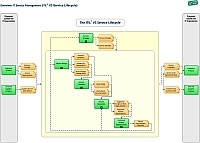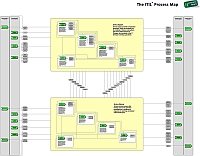ITIL Processes: Difference between revisions
No edit summary |
mNo edit summary |
||
| Line 1: | Line 1: | ||
<seo metakeywords="itil processes, itil process, itil v3 processes, itil v2 processes, itil disciplines" metadescription="ITIL Version 3 (ITIL V3) encompasses five core disciplines (follow the links to get to the pages with detailed ITIL process descriptions)." /> | |||
<imagemap> | |||
Image:ITIL-Wiki-de-es.jpg|DE - ES - ITIL Processes - Processes ITIL V3|100px | |||
rect 0 0 50 30 [https://wiki.de.it-processmaps.com/index.php/ITIL-Prozesse diese Seite auf Deutsch] | |||
rect 50 0 100 30 [https://wiki.es.it-processmaps.com/index.php/Procesos_ITIL esta página en español] | |||
desc none | |||
</imagemap> | |||
<br style="clear:both;"/> | |||
==ITIL Processes according to ITIL Version 3 (ITIL V3)== | == <span id="ITIL V3 Processes">ITIL Processes according to ITIL Version 3 (ITIL V3)</span> == | ||
IT Service Management | The processes ("ITIL Core Disciplines") within IT Service Management ensure that IT Services are provided in a focused, client-friendly and cost-optimized manner. With their help, IT Services are clearly defined, success can be measured with regards to the service provision, and targeted improvement measures can be introduced where necessary. | ||
===Service Strategy=== | ITIL Version 3 (ITIL V3) encompasses five core disciplines ''(follow the links to get to the pages with detailed ITIL process descriptions)'': | ||
[[Image:Itil-processes.jpg|thumb=thumb_poster_itil-process-map-v3.jpg|left|The ITIL V3 Lifecycle: [https://wiki.en.it-processmaps.com/images/pdf/itil_v3_service_lifecycle_itil-process-map-v3.pdf ITIL Processes]]] | |||
===ITIL Processes: [[ITIL V3 Service Strategy|Service Strategy]]=== | |||
Process Objective: To provide guidance on how to design, develop and implement Service Management. It is about ensuring that IT organizations are in position to achieve operational effectiveness and to offer distinctive services to their customers. Its ultimate goal is to make the IT organization think and act in a strategic manner. | Process Objective: To provide guidance on how to design, develop and implement Service Management. It is about ensuring that IT organizations are in position to achieve operational effectiveness and to offer distinctive services to their customers. Its ultimate goal is to make the IT organization think and act in a strategic manner. | ||
===[[ITIL V3 Service Design|Service Design]]=== | ===ITIL Processes: [[ITIL V3 Service Design|Service Design]]=== | ||
Process Objective: To design and develop IT services. Its scope includes the design of new services, as well as changes and improvements to existing ones. | Process Objective: To design and develop IT services. Its scope includes the design of new services, as well as changes and improvements to existing ones. | ||
===[[ITIL V3 Service Transition|Service Transition]]=== | ===ITIL Processes: [[ITIL V3 Service Transition|Service Transition]]=== | ||
Process Objective: To build and deploy IT services. It also makes sure that changes to services and Service Management processes are carried out in a coordinated way. | Process Objective: To build and deploy IT services. It also makes sure that changes to services and Service Management processes are carried out in a coordinated way. | ||
===[[ITIL V3 Service Operation|Service Operation]]=== | ===ITIL Processes: [[ITIL V3 Service Operation|Service Operation]]=== | ||
Process Objective: To make sure that IT services are delivered effectively and efficiently. This includes fulfilling user requests, resolving service failures, fixing problems, as well as carrying out routine operational tasks. | Process Objective: To make sure that IT services are delivered effectively and efficiently. This includes fulfilling user requests, resolving service failures, fixing problems, as well as carrying out routine operational tasks. | ||
=== Continual Service Improvement=== | ===ITIL Processes: [[ITIL V3 CSI - Continual Service Improvement|Continual Service Improvement (CSI)]]=== | ||
Process Objective: The Continual Service Improvement process uses methods from quality management in order to learn from past successes and failures. It implements a closed-loop feedback system as specified in ISO 20000 as a means to continually improve the effectiveness and efficiency of IT services and processes. | Process Objective: The Continual Service Improvement process uses methods from quality management in order to learn from past successes and failures. It implements a closed-loop feedback system as specified in ISO 20000 as a means to continually improve the effectiveness and efficiency of IT services and processes. | ||
==ITIL Processes according to ITIL Version 2 (ITIL V2)== | ==ITIL Processes according to ITIL Version 2 (ITIL V2)== | ||
[[Image:thumb_high_level_view_itil_v2_it_service_management.jpg | [[Image:Processes-itil-v2.jpg|thumb=thumb_high_level_view_itil_v2_it_service_management.jpg|left|The ITIL V2 Process Map showing the greater associations between the [https://en.it-processmaps.com/media/poster_itil_process_map.pdf ITIL Processes]]] | ||
IT Service Management according to | IT Service Management according to ITIL V2 encompasses the following processes (follow the links to get to the pages with detailed descriptions): | ||
===[[Service Support]]=== | ===ITIL Processes: [[Service Support]]=== | ||
Service Support provides all operative Processes necessary for the handling of Service interruptions and for the implementation of Changes; the availability of the IT Services is thereby guaranteed. | Service Support provides all operative Processes necessary for the handling of Service interruptions and for the implementation of Changes; the availability of the IT Services is thereby guaranteed. | ||
===[[Service Delivery]]=== | ===ITIL Processes: [[Service Delivery]]=== | ||
Service Delivery ensures that binding rules for the operative Processes are in existence. It regulates the planning, contractual and financial topics. | Service Delivery ensures that binding rules for the operative Processes are in existence. It regulates the planning, contractual and financial topics. | ||
<br style="clear:both;"/> | |||
<i><small>[[Main Page|Home]] > [[ITIL Processes|ITIL Processes]]</small></i> | |||
<!-- This page is assigned to the following categories: --> | |||
[[Category:ITIL discipline|!]][[Category:ITIL process|!]] | |||
<!-- --- --> | |||
Revision as of 09:26, 11 July 2011
<seo metakeywords="itil processes, itil process, itil v3 processes, itil v2 processes, itil disciplines" metadescription="ITIL Version 3 (ITIL V3) encompasses five core disciplines (follow the links to get to the pages with detailed ITIL process descriptions)." />

ITIL Processes according to ITIL Version 3 (ITIL V3)
The processes ("ITIL Core Disciplines") within IT Service Management ensure that IT Services are provided in a focused, client-friendly and cost-optimized manner. With their help, IT Services are clearly defined, success can be measured with regards to the service provision, and targeted improvement measures can be introduced where necessary.
ITIL Version 3 (ITIL V3) encompasses five core disciplines (follow the links to get to the pages with detailed ITIL process descriptions):

ITIL Processes: Service Strategy
Process Objective: To provide guidance on how to design, develop and implement Service Management. It is about ensuring that IT organizations are in position to achieve operational effectiveness and to offer distinctive services to their customers. Its ultimate goal is to make the IT organization think and act in a strategic manner.
ITIL Processes: Service Design
Process Objective: To design and develop IT services. Its scope includes the design of new services, as well as changes and improvements to existing ones.
ITIL Processes: Service Transition
Process Objective: To build and deploy IT services. It also makes sure that changes to services and Service Management processes are carried out in a coordinated way.
ITIL Processes: Service Operation
Process Objective: To make sure that IT services are delivered effectively and efficiently. This includes fulfilling user requests, resolving service failures, fixing problems, as well as carrying out routine operational tasks.
ITIL Processes: Continual Service Improvement (CSI)
Process Objective: The Continual Service Improvement process uses methods from quality management in order to learn from past successes and failures. It implements a closed-loop feedback system as specified in ISO 20000 as a means to continually improve the effectiveness and efficiency of IT services and processes.
ITIL Processes according to ITIL Version 2 (ITIL V2)

IT Service Management according to ITIL V2 encompasses the following processes (follow the links to get to the pages with detailed descriptions):
ITIL Processes: Service Support
Service Support provides all operative Processes necessary for the handling of Service interruptions and for the implementation of Changes; the availability of the IT Services is thereby guaranteed.
ITIL Processes: Service Delivery
Service Delivery ensures that binding rules for the operative Processes are in existence. It regulates the planning, contractual and financial topics.






